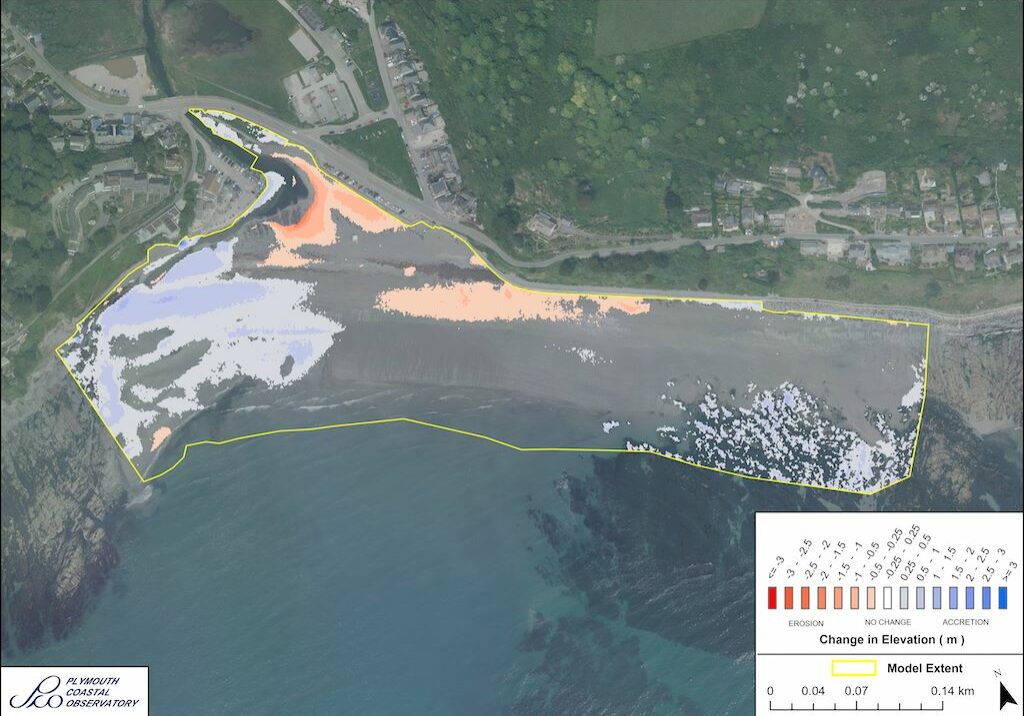
Seaton (Cornish: ‘Sethyn’, meaning ‘little arrow or twisting river’) is a south facing beach in South-East Cornwall, located at the mouth of the River Seaton, which meanders across the beach after flowing through the steep sided, wooded Hessenford valley. Aside from a car park and recreational spaces, the bottom of the valley remains undeveloped and forms part of the wider Seaton Valley Country Park and Nature Reserve.
The sand on Seaton Beach consists of coarse grey sand mixed with patches of shingle and the beach is fringed by outcrops of weathered rock. The upper shore of the beach is dominated by differing styles of seawall that, collectively, create a boundary between the natural and man-made environment. The village itself includes small number of shops lining the edge of the valley this then merges with the village of Downderry further to the east.


Coastal Change
The coastline of Cornwall is an ever-changing environment. Its energetic, dynamic, never still and changes with each wave and each tidal cycle. Some of the changes we see are gradual and barely noticeable, whilst others, such as rockfalls, happen suddenly and often shockingly.
From one visit to the next it can sometimes be difficult to see how a beach and dune system has changed, but information has been collected, and is being collected through the Making Space for Sand project, to help us better understand how the coastline is changing. The purpose of this section of the website is to understand each location has changed over time, how it could change in the future and understand the policies that influence how we can respond to these changes.
Shoreline Management Plans (SMP)
The Shoreline Management Plan (SMP) is a strategic planning and management assessment tool that helps identify and measure the risk associated coastal erosion and coastal flooding. The document makes a number of policy recommendations over short, medium and long term timeframes setting out a strategic approach to managing the built, natural and historic environments associated with the coastline. Within SMP there are four policy approaches which have been assigned to stretches of coastlines. The four policies are: No Active Intervention (NAI), Hold the Line (HTL), Managed realignment (MR), and Advance the line (ATL).
Seaton sits within Policy Development Zone 1 (PDZ1), in Management Area 2 (MA2), within Policy Units (PU) 2.2 and 2.3. The policy recommendations for these policy units are detailed in the table below.
Use your touchscreen
to scroll the below table
| Policy Unit | Policy Plan | ||||
| 2025 | 2055 | 2105 | Comment | ||
| 2.1 | Downderry East
Main Policy Sub Policy |
NAI LAO |
NAI LAO |
NAI LAO |
Commitment from Cornwall Council to ongoing monitoring of the ‘Action Line’, to provide an ongoing re-assurance to the community. Most recent monitoring indicates maximum erosion of around 300mm over 5 years. Private defences have slowed down natural rates of erosion, though not all local defences have permission and local management activity will be kept under review. Allow continuation of the natural slower erosion at Downderry east of Beach Hill, supported by ongoing monitoring. |
| 2.2 | Downderry West & Seaton
Main Policy Sub Policy |
HTL RNR
|
MR SE |
MR SE |
Initially hold defences during epoch 1, continuing SMP1 policy. Longer term objective is to allow coast to adjust in medium to longer term through managed realignment, which would require development planning support to manage the relocation of existing property away from high-risk zones. The implications of this approach for highway links along this section will also be considered. Private defences in this section have slowed down natural rates of erosion, though not all local defences have permission and local management activity will be kept under review. |
| 2.3 | Seaton Beach
Main Policy Sub Policy
|
MR NF |
NAI CtM |
NAI CtM |
Return to a naturally functioning frontage by gaining commitment to early realignment of the road to achieve robust resilience to future flooding, whilst maintaining community connectivity. Any realignment should not reduce the capacity of the river to discharge. |
| Key Main Policy: HTL - Hold the Line, A - Advance the Line, NAI – No Active Intervention MR – Managed Realignment,
Sub Policy: LAO - Local Activity Only, RNR - Repair Not Replace, SE - Slow Erosion, NF - Natural Features, CtM - Cease to Maintain |
|||||
The SMP can be accessed through the Cornwall Council website using this link: Cornwall and Isles of Scilly Shoreline Management Plan 2


NCERM (National Coastal Erosion Risk Mapping)
National Coastal Erosion Risk Mapping (NCERM) provides a baseline of coastal erosion, for the coastline of England, over short, medium and long-term timeframes. The data is based on the natural and defence characteristics of the coastline and provides rates of erosion at differing levels of confidence to help better plan for worse case scenarios. The data provided is for guidance and does not estimate the absolute location of the future coastline.
The basic NCERM lines show erosion estimates for the Short Term (ST-20 years), Medium Term (MT-50 years) and Long Term (LT- 100 years). The data is further categorised by probability: 05 is 5% probability (a 1 in 20 chance of being exceeded) Red Shading, 50 is 50% probability of being exceeded (a 1 in 2 chance of being either exceeded or not exceeded) Orange Shading and 95 is 95% probability (a 19 in 20 chance of being exceeded) Yellow Shading.
Historical Images
Historical photographs provide a powerful insight into how the Cornish coastline has changed within the past Century. The Making Space for Sand project are working in collaboration with the Francis Frith collection and have been given permission to share historical images on a number of beaches considered within the project.
In looking back, we can better understand how the coastline has changed, helping us understand not only how the coastal fringe has developed but also the potential future changes that we my observe. When this is considered alongside forecasts of coastal erosion and sea level rise it will help enable us to better adapt to our changing coastline.
Seaton beach from eastern cliffs in 1930 (Image courtesy of the Francis Frith collection) and in 2024.
Bridge Road at Seaton c1950 (Image courtesy of the Francis Frith collection) and in 2024.
View of seaton valley from Tregunnick Lane c1965 (Image courtesy of the Francis Frith collection) and in 2024.

Modelling Coastal Change

The gathering of data will enhance our understanding of beach-dune dynamics and how these are affected by the increasing strength of storm events and sea level rise. It will consider the movement of the sand by wind and tide and how this effects the growth of dune systems. Computer modelling will then be used to predict how the shoreline and the beach-dune systems may change over the next 50 to 100 years.
The ultimate aim is to compare the topographic changes to the beach-dune systems to other datasets (e.g. wave heights, wind and rainfall) to make connections between cause and effect.
LiDAR surveys, which are explained on the Data Modelling page, have been carried out by the South West Coastal Monitoring program at this location. The image shared here visualises where sand has eroded (areas shaded in red) and where it has built up (areas shaded in blues), between the LiDAR surveys carried out in 2008 and 2020. The darker the shade of red or blue the greater the amount of sand erosion or accumulation has been observed. The image helps visualise that beaches are areas that change shape over time and will continue to do so as sea levels rise.


Designations
The coastline represents an important transition between the marine environment and the terrestrial environment. This transition creates a range of special habitats and exposes a range of interesting features, which that can result in these spaces being highly designated and protected. There are a range of designations that recognise a variety of different features. At this location these designations are explored below.
Marine Conservation Zone (MCZ)
A Marine Conservation Zone (MCZ) is a type of marine protected area, designated in English, Welsh and Northern Ireland territorial offshore waters, to protect a range of nationally important, rare or threatened marine habitats or species by halting or reversing damage and degradation caused by human activities.
The Whitsand and Looe Bay MCZ covers an area of 52km2, extending along the mean high water mark from Portnadler Bay to Rame Head. The sediment supports populations of bivalve molluscs and marine worms and provides a habitat for commercially important fish and shellfish, while the site’s intertidal rocky habitats are characterised by animals such as sponges, sea squirts and the rare giant goby. Further out to sea there are shipwrecks and small areas of subtidal rocky reef that support pink sea-fans and rare sea-fan anemones.
Image of an edible crab (Courtesy of Tony Sutton)
Sign up to Making Space for Sand
If you would like to get involved in helping to make dunes more resilient and biodiverse, want to help develop coastal adaptation and emergency plans or just want to know more about what the project is learning about coastal change, please click here:








